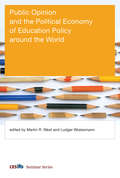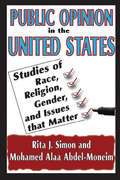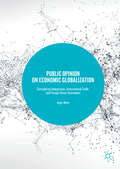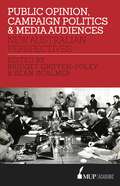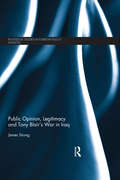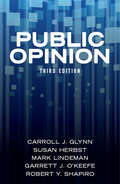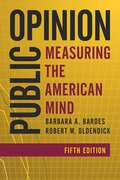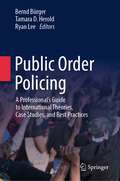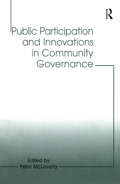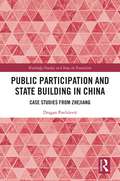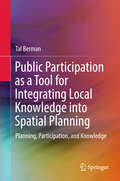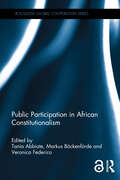- Table View
- List View
Public Opinion and the Political Economy of Education Policy around the World (CESifo Seminar Series)
by Martin R. West and Ludger WoessmannComparative analyses of the influence of public opinion on education policy in developed countries.Although research has suggested a variety of changes to education policy that have the potential to improve educational outcomes, politicians are often reluctant to implement such evidence-based reforms. Public opinion and pressure by interest groups would seem to have a greater role in shaping education policy than insights drawn from empirical data. The construction of a comparative political economy of education that seeks to explain policy differences among nations is long overdue. This book offers the first comparative inventory and analysis of public opinion and education in developed countries, drawing on data primarily from Europe and the United States.
Public Opinion in the United States: Studies of Race, Religion, Gender, and Issues That Matter
by Rita J. SimonPublic Opinion in the United States tracks developments in American society since World War II through the lens of public opinion. The authors assess national public opinion poll data from 1945 to 2008, targeting opinions about African Americans, Jews, Muslim Americans, gays and lesbians, immigration, abortion, and affirmative action. The authors consider whether American attitudes have developed faster than Supreme Court decisions in the areas surveyed. They assess how social change is processed by the public, how people responded to the race riots of the 1950s and 1960s, and how the war in Vietnam shaped new perspectives on issues such as race, citizenship rights, and the role of the individual. Each chapter begins by introducing the political, social, or international events that were critical in setting the stage for influencing public opinion in each decade since World War II. The volume provides a unique portrait of American society and how it has changed over the last sixty plus years. The reader will learn whether Americans are more or less prejudiced against blacks, Jews, and Muslims than they were in earlier years; whether their views on immigration, affirmative action, and abortion have changed; and when views have changed, in what direction. Do men and women, rich and poor, more and less educated, secular versus religious share the same views? And if there are differences, what directions do those differences take? Th is work describes American society in 2008 compared to the post-World War II era, and it offers stunning glimpses at the future.
Public Opinion on Economic Globalization
by Roger WhiteThis book examines survey data to consider the extent to which public support for immigration, international trade, and foreign direct investment exists in a cohort of 38 heterogeneous countries. With economic globalization shaping daily life, understanding the determinants of public opinion is crucial for policy makers. This timely volume uses survey data from the Pew Research Center's 2006-2014 Global Attitudes Project (GAP) in conjunction with data from several secondary sources. White identifies the factors that underlie the reluctance of some members of the public, and some societies, to view these topics in a more positive light. Specifically, he considers the roles of culture, cultural differences ("cultural distance"), and relative social and economic development as determinants of public opinion and corresponding cross-societal differences of opinion.
Public Opinion, Campaign Politics & Media Audiences: New Australian Perspectives
by Bridget Griffen-Foley Associate Professor Sean ScalmerThis timely book investigates the fascinating landscape of media-driven politics through the prisms of 'public opinion', political campaigning, and audiences.From Indigenous voting rights and climate change to talkback radio and right-wing populism, Public Opinion, Campaign Politics & Media Audiences showcases new research in political science, history and media studies. Contributors scrutinise the relationship between polls, party policy and voting behaviour, and evaluate the roles of oratory and the media in electioneering and political communication across Australia, Britain and the United States.The eight chapters are based on papers delivered at a symposium to honour Murray Goot FASSA, Emeritus Professor of Politics and International Relations, on his retirement from Macquarie University.
Public Opinion, Legitimacy and Tony Blair’s War in Iraq (Routledge Studies in Foreign Policy Analysis)
by James StrongIn the wake of the publication of the Chilcot report, this book reinterprets the relationship between British public opinion and the Blair government’s decision-making in the run-up to the 2003 invasion of Iraq. It highlights how the government won the parliamentary vote and got its war, but never won the argument that it was the right thing to do. Understanding how, why and with what consequences Britain wound up in this position means understanding better both this specific case and the wider issue of how democratic publics influence foreign policy processes. Taking an innovative constructivist approach to understanding how public actors potentially influence foreign policy, Strong frames the debate about Iraq as a contest over legitimacy among active public actors, breaking it down into four constituent elements covering the necessity, legality and morality of war, and the government’s authority. The book presents a detailed empirical account of the British public debate before the invasion of Iraq based on the rigorous interrogation of thousands of primary sources, employing both quantitative and qualitative content analysis methods to interpret the shape of debate between January 2002 and March 2003. Also contributing to the wider foreign policy analysis literature, the book investigates the domestic politics of foreign policy decision-making, and particularly the influence public opinion exerts; considers the domestic structural determinants of foreign policy decision-making; and studies the ethics of foreign policy decision-making, and the legitimate use of force. It will be of great use to students and scholars of foreign policy analysis, as well as those interested in legitimacy in international conflict, British foreign policy, the Iraq War and the role of public opinion in conflict situations.
Public Opinion, Transatlantic Relations and the Use of Force
by Philip Everts Pierangelo IserniaThis book explores the intersection of the study of transatlantic relationships and the study of public support for the use of force in foreign policy. It contributes to two important debates: one about the nature of transatlantic partnership, and another about the determinants of support for the use of military force in a comparative perspective.
Public Opinion, the First Ladyship, and Hillary Rodham Clinton (Women and Politics)
by Barbara BurrellThis second edition presents Clinton's self-repositioning during the 1996 election, her official role during the second term, her role during the impeachment proceedings, and the beginnings of an independent political career.
Public Opinion: Democratic Ideals, Democratic Practice
by Rosalee A. Clawson Zoe M. OxleyIn this revision of their lauded Public Opinion: Democratic Ideals, Democratic Practice, Rosalee A. Clawson and Zoe M. Oxley continue to link the enduring normative questions of democratic theory to the best empirical research on public opinion. Exploring the tension between ideals and their practice, each chapter focuses on exemplary studies so that students gain a richer understanding of key findings and the research process as well as see methods applied in context.
Public Opinion: Democratic Ideals, Democratic Practice
by Rosalee A. Clawson Zoe M. OxleyIn this revision of their lauded Public Opinion: Democratic Ideals, Democratic Practice, Rosalee A. Clawson and Zoe M. Oxley continue to link the enduring normative questions of democratic theory to the best empirical research on public opinion. Exploring the tension between ideals and their practice, each chapter focuses on exemplary studies so that students gain a richer understanding of key findings and the research process as well as see methods applied in context.
Public Opinion: Democratic Ideals, Democratic Practice
by Rosalee A. Clawson Zoe M. OxleyIn Public Opinion: Democratic Ideals, Democratic Practice, Fourth Edition, Clawson and Oxley link the enduring normative questions of democratic theory to existing empirical research on public opinion. Organized around a series of questions—In a democratic society, what should be the relationship between citizens and their government? Are citizens’ opinions pliable? Are they knowledgeable, attentive, and informed?—the text explores the tension between ideals and their practice. Each chapter focuses on exemplary studies, explaining not only the conclusion of the research, but how it was conducted, so students gain a richer understanding of the research process and see methods applied in context.
Public Opinion: Democratic Ideals, Democratic Practice
by Rosalee A. Clawson Zoe M. OxleyIn Public Opinion: Democratic Ideals, Democratic Practice, Fourth Edition, Clawson and Oxley link the enduring normative questions of democratic theory to existing empirical research on public opinion. Organized around a series of questions—In a democratic society, what should be the relationship between citizens and their government? Are citizens’ opinions pliable? Are they knowledgeable, attentive, and informed?—the text explores the tension between ideals and their practice. Each chapter focuses on exemplary studies, explaining not only the conclusion of the research, but how it was conducted, so students gain a richer understanding of the research process and see methods applied in context.
Public Opinion: How Political Actors View The Democratic Process (Studies In Communication, Media, And Public Opinion)
by Carroll J. GlynnPublic Opinion is a comprehensive and multidisciplinary examination of public opinion in the United States. Drawing on scholarship in political science, psychology, sociology, and communications, the authors explore the nature of political and social attitudes in the United States and how these attitudes are shaped by various institutions, with an emphasis on mass media. The book also serves as a provocative starting point for the discussion of citizen moods, political participation, and voting behavior. Feature boxes and illustrations throughout help students understand all aspects of the elusive phenomenon we call public opinion. The third edition has been thoroughly revised and updated to reflect how public opinion is studied today, and to incorporate current data and debates. The book now contains two revised and reframed theory chapters 'Group Membership and Public Opinion' and 'Public Opinion and Social Process', as well as new coverage of the influence of online and social media on public opinion, especially in issue opinions and campaigns.
Public Opinion: Measuring the American Mind
by Barbara Bardes Robert OldendickPublic Opinion: Measuring the American Mind provides an in-depth look at the history and future of polling, including how public opinion is measured, how it is used and misused, and how to critically evaluate public opinion data. This new edition incorporates a new theme of political polarization and examines how mass media and social media help to shape public opinion. It also provides in-depth coverage of public opinion on such issues as political ideology, health care, race, and foreign policy, as well as an update and discussion of the major changes that have taken place on controversial issues such as gay marriage, gun control, and immigration.
Public Order Policing in Hong Kong: The Mongkok Riot (Palgrave Advances in Criminology and Criminal Justice in Asia)
by Kam C. WongThis book examines the Hong Kong Mongkok Riot (MKR) of 2016 to offer a clear and objective account of the events as they unfolded, to dispel the myths, and to explore what can be learned from it. It draws on multiple sources including: public survey data, eyewitness accounts, LegCo proceedings, official press releases, newspaper reports, and video presentations. The study investigates the causes, issues and impacts of MKR including how the media reported it. It examines the historical context surrounding MKR, before and after, and considers the importance of this independent inquiry including its use and limitations. It aims to bring closure to the event, establish a record for the future, provide insightful data for cross-cultural studies on riots, and offer insights for police scholars, security consultants, political scientists, Asian and Chinese studies scholars, and comparative criminal justice researchers.
Public Order Policing: A Professional's Guide to International Theories, Case Studies, and Best Practices
by Ryan Lee Bernd Bürger Tamara D. HeroldSuccessful public order management is critical to upholding democracy and maintaining the rule of law. Negative police-public interactions during assemblies can impact the safety and well-being of citizens and officers, as well as local and international perceptions of police legitimacy. As observed during events across the world, including assemblies in the U.S., Myanmar, Belarus, Russia, and elsewhere, police mismanagement of mass demonstrations often instigates crowd violence and other harmful behaviors. The causes of violence at assemblies are complex and multi-faceted. Failure to understand crowd dynamics that lead to violence limits police effectiveness and contributes to poor officer decision-making. This book offers an international review of public order management experiences and effective practices. Practical examples, grounded in multi-disciplinary theory and science, offer a roadmap to improve police response and increase safety at assemblies in democratic countries. The diverse content, perspectives, and lessons learned presented in this volume will serve as a useful guide for all people working in the field of public order management, including police officials, policymakers, and researchers. This edited volume was written by and for practitioners, pracademics, and academics to review the complex and demanding task of policing public order.
Public Order and Private Lives: The Politics of Law and Order (Routledge Revivals)
by Chris Hale Michael BrakeFirst published in 1992, Public Order and Private Lives is a radical examination of the political forces which shaped the law and order debate in Britain at that time. The authors offer a significant and provoking analysis of Conservative policies on crime, showing that, ironically, they created the very social conditions in which crime flourished. The book argues that the Conservative government undermined basic civil liberties by its increased use of legislation as a means of control and coercion, and as a result of this, crime increased under their governance.
Public Organizations in Asia
by Tobin ImPublic Organizations in Asia introduces students to the fundamental theories of organizations and teaches them how to analyze different types of public organizations in East and Southeast Asia. Moving away from traditional Western theory and examples, this textbook provides numerous case studies of Asian organizations where different ideologies, administrative tradition, and social circumstances prevail. Key pedagogical features of Public Organizations in Asia include: Learning objectives for each chapter End of chapter discussion questions Short student exercises Concise case studies throughout the chapters Training students to be future leaders of Asian public organizations, this book is an essential text for undergraduate and graduate courses on public administration in Asia. It will also be a useful supplementary text for courses on comparative public administration.
Public Participation In Development Planning And Management: Cases From Africa And Asia
by Jean-claude Garcia-zamorThis book examines the position held by most development administrators that citizen participation in the planning and management of development projects is crucial to their lasting success. The contributors view inadequate participation as part of the larger problem of ineffective management, policies, and planning. They show that development obje
Public Participation and Innovations in Community Governance
by Peter McLavertyComprised of a series of national case studies, this book critically examines initiatives in public participation and their relationship to developments in community governance. As such, the case studies enable national perspectives to be applied to crucial features of modern public policy and politics. Focusing on case studies in areas which are undergoing major social and institutional transformation and/or which raise particular issues because of the marginal position of the areas within their nation-states, the book also concerns itself with developments in Western European countries and why people should logically support some but not other initiatives in public participation. This book will be very useful for students and academics in areas such as politics, public administration, social policy and sociology. It should also be of interest to local activists such as councillors, members of pressure groups and those concerned about modern trends in democracy.
Public Participation and Legitimacy in the WTO
by Yves BonzonThe legitimacy of the WTO's decision-making process has always been questioned, and many have advocated public participation mechanisms as a remedy. Yves Bonzon considers the limits and potential of these mechanisms by advancing a conceptual framework which distinguishes the four 'implementation parameters' of public participation: the goal, the object, the modalities, and the actors. He addresses the issue of legitimacy by considering to what extent, and by virtue of which legal developments, one can see implementing the democratic principle as a goal for public participation in the context of the WTO. By analysing the institutional structure of the WTO and its different types of decisions, he then outlines how this goal should influence the object and modalities of public participation, which decision-making procedures should be opened to public participation, and how the mechanisms should be implemented in practice. Finally, he suggests specific amendments to existing WTO arrangements on public participation.
Public Participation and State Building in China: Case Studies from Zhejiang (Routledge Studies on China in Transition)
by Dragan PavlićevićThis book explores non-electoral means of public participation in contemporary China, both as an outcome of and a key contributor to the party-state’s efforts to improve its governing capacity. Examining consultative meetings, public hearings, and the use of surveys and questionnaires in Zhejiang province, on an empirical level, the study evaluates the historical development and institutional backgrounds of these mechanisms, as well as provides a critical assessment of their achievements and failures. At the same time, on a theoretical level, this book contributes to the broader scholarship on contemporary Chinese politics and political development within one-party regimes, as well as debates about state building and democratisation. Relying on the distinction between access to and exercise of power, it concludes that non-electoral public participation is in fact a function of state building. Developing a state capable of producing effective solutions to governing challenges, it is argued, requires public participation in the governing process. With analysis informed by interviews with local-level policy-makers and officials, academics, and citizens’ representatives and activists, Public Participation and State Building in China will be a valuable research resource for students and scholars of Chinese politics, political science, and civil society.
Public Participation as a Tool for Integrating Local Knowledge into Spatial Planning
by Tal BermanThis book provides a state of the art approach to participatory planning, and generates innovative thought in planning theory and knowledge study. The book introduces a new conceptual framework for participatory planning, one which redefines concepts that have been taken for granted for too long: those of "public participation" and "local knowledge". It draws on the rich repertoire of public participation practices that have developed globally over the last 50 years, and investigates the following questions: Which participatory practices most effectively capture residents' genuine spatial needs, perceptions and desires? And how can these be incorporated into actual plans? The book is based on an empirical comparative examination of the effectiveness of various participatory processes, and proposes practical solutions for public participation through two new instruments: the Practices Evaluation Tool, and the Participatory Methods Ladder. These instruments calibrate participation methods according to certain criteria, in order to improve their ability to extract local knowledge and incorporate it into planning deliverables. These new instruments correspond to and elaborate on Arnstein's ladder - the 1969 theoretical landmark for participatory planning. Both academics and practitioners in the area of urban and regional planning will find this book to be an invaluable resource, given the way it develops both theoretical and practical cutting-edge outcomes.
Public Participation for 21st Century Democracy
by Tina Nabatchi Matt Leighningerehind and practice of participatory governanceContains a wealth of detailed case studies that explore the application of public participationCovers vital issues such as immigration, race, and difference; public finance, poverty, and economic development; land use and the environment; public safety and public health; and schools and educationAccompanying instructor resources include; case studies and research from www.participedia.net, discussion questions, sample assignments, and classroom activities
Public Participation in African Constitutionalism (Routledge Global Cooperation Series)
by Tania Abbiate, Markus Böckenförde and Veronica FedericoDuring the last decade of the 20th century, Africa has been marked by a "constitutional wind" which has blown across the continent giving impetus to constitutional reforms designed to introduce constitutionalism and good governance. One of the main features of these processes has been the promotion of public participation, encouraged by both civil society and the international community.This book aims to provide a systematic overview of participation forms and mechanisms across Africa, and a critical understanding of the impact of public participation in constitution-making processes, digging beneath the rhetoric of public participation as being at the heart of any successful transition towards democracy and constitutionalism. Using case studies from Central African Republic, Egypt, Kenya, Libya, Malawi, Morocco, Senegal, Somalia, South Africa, South Sudan, Tanzania, Tunisia, Zambia and Zimbabwe, the book investigates various aspects of participatory constitution making: from conception, to processes, and specific contents that trigger ambivalent dynamics in such processes. The abstract glorification of public participation is questioned as theoretical and empirical perspectives are used to explain what public participation does in concrete terms and to identify what lessons might be drawn from those experiences.This is a valuable resource for academics, researchers and students with an interest in politics and constitution building in Africa, as well as experts working in national offices, international organizations or in national and international NGOs.
Public Participation in Environmental Assessment and Decision Making
by National Research Council of the National AcademiesFederal agencies have taken steps to include the public in a wide range of environmental decisions. Although some form of public participation is often required by law, agencies usually have broad discretion about the extent of that involvement. Approaches vary widely, from holding public information-gathering meetings to forming advisory groups to actively including citizens in making and implementing decisions. Proponents of public participation argue that those who must live with the outcome of an environmental decision should have some influence on it. Critics maintain that public participation slows decision making and can lower its quality by including people unfamiliar with the science involved. This book concludes that, when done correctly, public participation improves the quality of federal agencies' decisions about the environment. Well-managed public involvement also increases the legitimacy of decisions in the eyes of those affected by them, which makes it more likely that the decisions will be implemented effectively. This book recommends that agencies recognize public participation as valuable to their objectives, not just as a formality required by the law. It details principles and approaches agencies can use to successfully involve the public.
